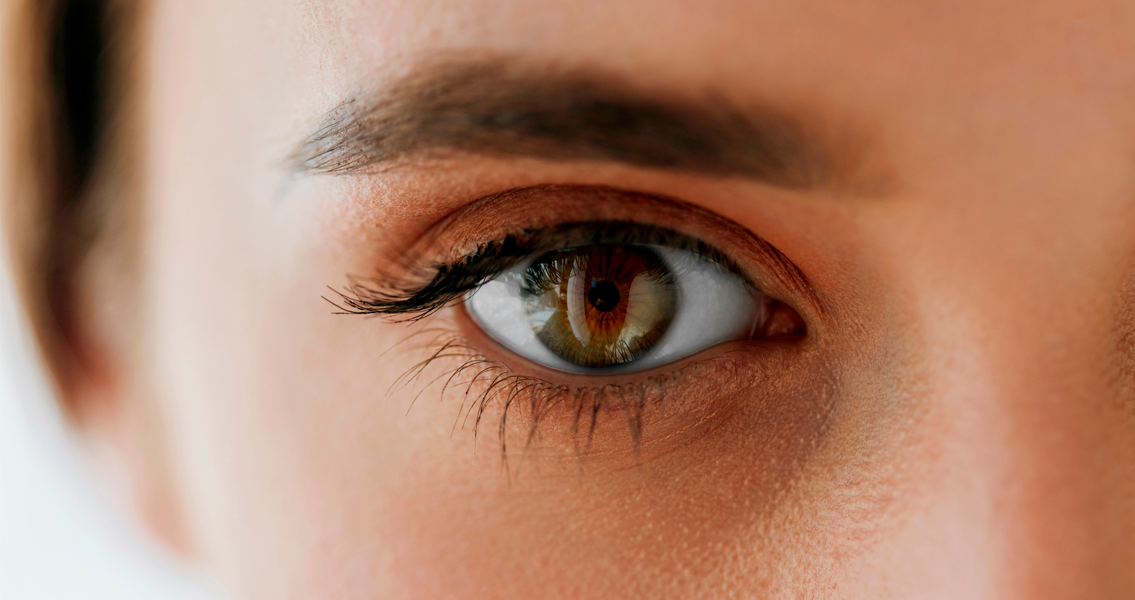One of the problems that causes the highest number of ophthalmology visits is dry eye syndrome (SOS). It is estimated that this syndrome affects 15 to 30% of the population.
This is an eye disorder caused by a decrease in tear production or increased evaporation of water in the tear, which deteriorates its composition and quality and decreases the tear films ability to lubricate and nourish the eye. As a result, there are various symptoms and complaints that affect visual acuity. The problem is important because tears have a protective and nourishing effect on the eye, they help to remove debris and foreign bodies from the eye and protect against infections
.
Tears are composed of a watery part, a mucin layer and a lipid part that is made up of fatty acids that are produced by the eyelid glands, whose function is to prevent tear water from evaporating.

The main symptoms of dry eye are tearing, itching, stinging, burning, redness, pain, swelling, and blurred vision.
Dry eyes make the eye more vulnerable to infection and, in severe cases, damage to the cornea can occur
.
Initially, this syndrome was mainly associated with aging, because over the years the quality of tear production decreases, and also because drug consumption increases with age due to the increase in age-related diseases, such as high blood pressure, metabolic diseases, diseases of the central nervous system, to name a few examples. In this regard, the problem will become increasingly acute due to the increase in life expectancy.
However, lifestyle and environmental factors are also becoming increasingly important causes of dry eyes. On the one hand, in recent years, exposure to digital screens (computers, tablets, mobile phones, etc.) that populate our lives and that are advancing and aggravating dry eye problems has increased exponentially, since the use of screens decreases flicker and increases tear evaporation. On the other hand, environmental factors such as atmospheric pollution that attacks the surface of the eye and irritates it, or the dryness caused by air conditioners and heating.

The same happens after long periods of driving or reading, which force us to fix our eyes, since in these cases the blinking and therefore the wetting of the eye due to the tear is also reduced. In addition, more and more people wear contact lenses from an earlier age, which also influences eye dryness
.
The usual treatment for dry eye is the use of artificial tears and eye lubricants. However, these treatments are often not enough and people with dry eye suffer a deterioration in their quality of life.
For some time now, to combat this problem, it has been recommended to increase the consumption of fatty acids to nourish the lipid layer of the tear (which is composed of fatty acids), since tear deterioration is often caused by a decrease in the production of lipids that are secreted by glands located in the eyelids (meibomian glands) and that prevent excess evaporation of water from the tear film.
Among the fatty acids that have been found to help improve dry eye symptoms is omega-7 fatty acid (palmitoleic acid), since its administration has been shown to balance the composition of the tear film, improve the function of the Meibomian glands and reduce inflammation by reducing the levels of
pro-inflammatory substances.
In two studies conducted in patients with dry eye, in one due to dysfunction of the Meibomian glands and, in the other, to various causes, similar results were obtained after 3 months of taking omega-7 fatty acids, with significant improvements with an average reduction of 33% in the severity of the symptoms of dry eyes.
Functions of palmitoleic acid
The nutritional and biological functions of palmitoleic acid are complex. It is a common component that, like other unsaturated fatty acids, forms part of the membranes of mucosal cells, making it essential both for their structure and for their functioning
.
As a source of palmitoleic acid, sea buckthorn fruit oil (Hippophae rhamnoides) is usually used, however, this oil contains about 25 to 43% of palmitoleic acid (depending on the variety and origin), but it can also contain a non-negligible amount of palmitic acid depending on the variety and origin, as shown in analyses carried out with different samples from the market, in which an average of 29% of palmitoleic acid and 32% of palmitic acid
.
 This palmitic acid is a long-chain saturated fatty acid, the most abundant in the diet (meats, dairy fats, palm and coconut oils…) but its consumption has been a cause for alarm due to an increase in intake over and above needs, which is related to cardiovascular disease and obesity. The increased consumption is also due to the fact that, apart from foods that naturally contain palmitic acid, the consumption of processed foods has increased, many of which contain palmitic acid in considerable quantities without the consumers perception of it. On the other hand, these processed foods may also contain contaminants generated in the refining process of these foods. Because of this, it does not seem appropriate to add more palmitic acid to the diet
This palmitic acid is a long-chain saturated fatty acid, the most abundant in the diet (meats, dairy fats, palm and coconut oils…) but its consumption has been a cause for alarm due to an increase in intake over and above needs, which is related to cardiovascular disease and obesity. The increased consumption is also due to the fact that, apart from foods that naturally contain palmitic acid, the consumption of processed foods has increased, many of which contain palmitic acid in considerable quantities without the consumers perception of it. On the other hand, these processed foods may also contain contaminants generated in the refining process of these foods. Because of this, it does not seem appropriate to add more palmitic acid to the diet
.
On the contrary, palmitoleic acid from marine sources, such as fish oil concentrate, with purified palmitoleic acid extracted from anchovies (Engraulis encrasicholus L) obtained from sustainable fishing off the coast of Peru. This concentrate [1] contains an average of 50% palmitoleic acid and only a maximum of 0.8% of free palmitic acid. And it is with this concentrate that one of the most important studies in dry eye has been carried out and with which another study has recently been launched.
CONCLUSION: Published studies with omega-7 (palmitoleic acid) supplementation have been shown to improve eye dryness due to different factors (environmental, lifestyle, hormonal, age-related decrease in secretion, use of contact lenses, systemic diseases, etc.), improving the quality of life of people who suffer from it.
[1] Provinal®
Bernstein AM, Roizen MF, Martinez L. Purified palmitoleic acid for the reduction of high-sensitivity C-reactive protein and serum lipids: a double-blinded, randomized, placebo-controlled study. J Clin Lipidol. 2014 Nov-Dec; 8 (6) :612-7. doi:10.1016/j.jacl.2014.08.001
.
Larmo et al. Effects of sea buckthorn oil intake on vaginal atrophy in postmenopausal women: A randomized, double-blind, placebo-controlled study. Maturitas 79 (2014) 316—321
Larmo et al. Oral Sea Buckthorn Oil Attenuates Tear Film Osmolarity and Symptoms in Individuals with Dry Eye. J. Nutr. 140:1462 - 1468, 2010.
Morris et al. Effects of Provinal® on dry eye symptoms. Tersus Life Sciences, LLC, Encinitas, CA. April 2017,
Morse. Lipid-lowering and anti-inflammatory effects of palmitoleic acid: Evidence from human intervention studies. Lipid Technology. July 2015, Vol. 27, No. 7 (2)
Morse. Lipid-lowering and anti-inflammatory effects of palmitoleic acid: Evidence from preclinical and epidemiological studies. Lipid Technology. May 2015, Vol. 27, No. 5, 107-111 review
Yang B and Erkkola R (2006) The 97th Annual Meeting & Expo of American Oil Chemists Society, April 30 — May 3, St Louis, USA
Yang et al. Effects of oral supplementation and topical application of supercritical co2 extracted sea buckthorn oil on skin ageing of female subjects. J. Appl. Cosmetol. 27, 1-13 (2009)
Yang et al. J. Agric. Fatty Acid Composition of Lipids in Sea Buckthorn (Hippophaë rhamnoides L.) Berries of Different Origins. Food Chem. 2001, 49, 1939-1947
Professor Mª José Alonso Osorio

- Graduated in Pharmacy from the University of Barcelona.
- Graduated in Phytotherapy from the University of Montpellier.
- Specialist in Galenic and Industrial Pharmacy.
- Technical Director and responsible for product development in the Pharmaceutical Industry (1972 to 1985).
- Community pharmacist (from 1985 to 2004 as owner and co-owner, since 2010 as a part-time substitute).
- Professor and tutor in Master and Postgraduate Phytotherapy UB - IL3 (University of Barcelona)
- Collaborating professor in the Masters Degree in Nutrition and Health, UOC (Open University of Catalonia)
- Member of the Governing Board of the Spanish Phytotherapy Society.
- Member of the Scientific Committee of INFITO (Center for Research on Phytotherapy).
- Member of the AEEM (Spanish Association for the Study of Menopause)
- Corresponding academic of the Royal Academy of Pharmacy of Catalonia.
All rights reserved ©. The reproduction, partial or total, of the content in any form is prohibited without the prior written consent of Cien Por Cien Natural SL. If you want to share the information, reproduction is allowed by citing Cien Por Cien Natural SL or using the link on their website. Cien Por Cien Natural SL is not responsible for misuse of the content of the article
.





